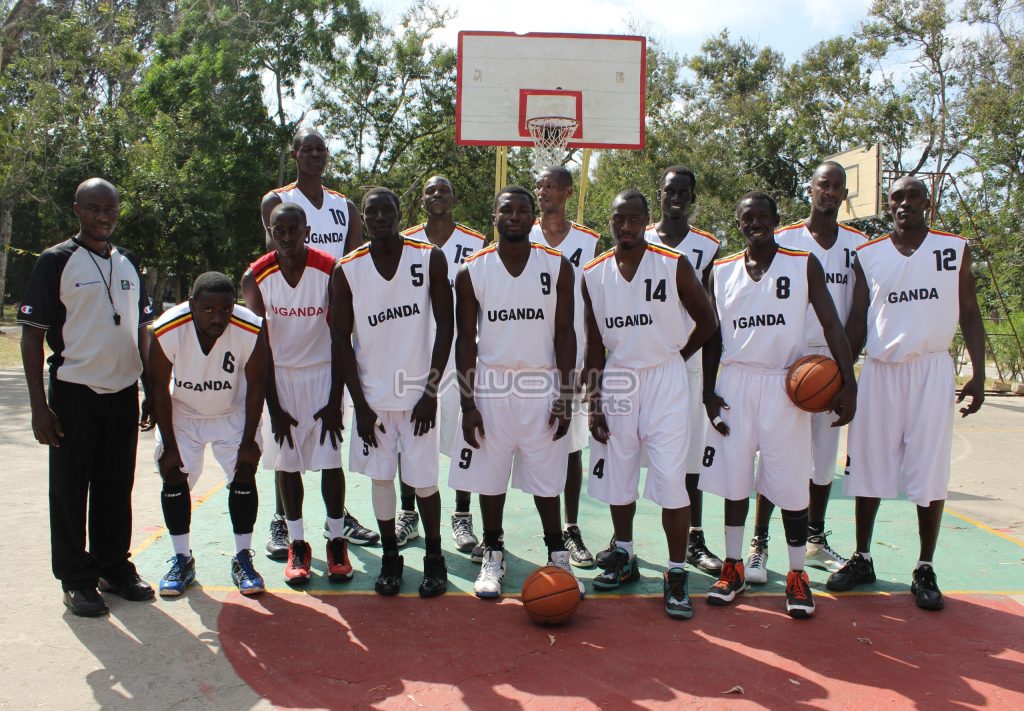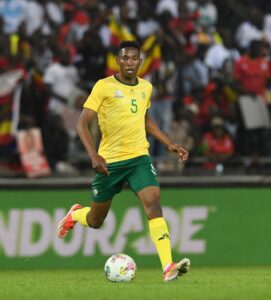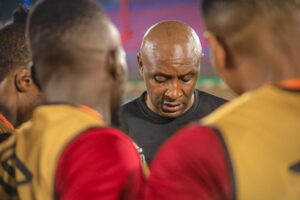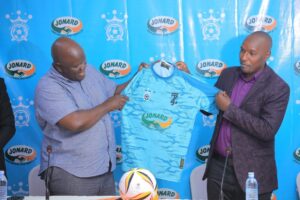In 2014, Uganda’s Silverbacks and Gazelles qualified for the 2015 FIBA AfroBasket and Women’s AfroBasket but as honourary FUBA President Ambrose Tashobya remembers, it was a process that started nearly seven years earlier.
Now, a third straight FIBA AfroBasket appearance is in the books for the Silverbacks (and chasing their fourth) while the Gazelles are just coming off their best-ever performance on the continent, a run that includes beating record champions Senegal.
From a mediocre, often considered an underdog even in regional competitions to outright challengers going neck to neck with continental giants, the East Africans have come of age. It has been a long and hard journey of transformation.
So, how was it done?
The Beginning
When Tashobya was elected as the Federation of Uganda Basketball Associations (FUBA) President in early 2007 ahead of incumbent John Ssimbwa (RIP), the Zone V All Africa Basketball Qualifiers were barely weeks away in Kigali, Rwanda.
Tashobya had just called it time on his playing career with two-time National Basketball League champions Kyambogo Warriors and it goes without saying he was a novice in sports administration.
“When I came into office in 2007, I found a big project of some zonal qualification tournament in Rwanda like two weeks away. Frankly, I didn’t have a big clue about what was happening on the inside. I was just asked to be president, I didn’t aspire to be,” Tashobya told Kawowo Sports.
“In my head, I was thinking everybody around the organization (FUBA) was working towards supporting the national team, supporting sports and all that but I got in there and the demands for the national team were out of this world to a point that there was hardly anything given to the national team by government, even the sport itself. The budget [from the government] was about four million and you are talking about taking U18s, senior teams to international events. We ultimately had to work with private companies to sponsor, and people who have a good heart for the sport to give you their money to support.”
Ambrose Tashobya Credit: FIBA
But Tashobya was determined to change everything around basketball in the country and more so the national teams, right from the underage teams.
What was important for me at that point was to put the national team in a position where the players and the fraternity can believe that if we have an outing, we will go.
Ambrose Tashobya, Honourary FUBA President
“At that time players would be like; ‘batuyise naye tugenda?’ and that would sway off some stars.”
Just to affirm the decision he had taken, Tashobya made sure the U18 girls’ team, against all odds, made the trip to Tunisia for the 2008 FIBA Africa U18 Championships for Women.
“We went for the U18 Girls’ Championships in Tunisia against all odds – of money and raising the team. I went with six girls, the seventh came later on the 3rd day because of passport issues. Raising the team was difficult because our U18s were S6 Candidates and most of the schools said No! But from that point, we gained a lot of respect [from FIBA] but most importantly for us was ‘when we say we are going [for a tournament], we have to go’ and so players at all levels, especially the senior level, started buying in.”
The American Blueprint
When Team USA suffered an embarrassment at the 2004 Olympic Games in Athens, Greece where they won bronze, a lot changed with the structure of USA Basketball. Among the changes was the hiring of Jerry Colangelo as the General Manager in 2005.
The 2006 FIBA World Cup was equally disappointing for the USA with another 3rd-place finish but the progress of USA Basketball since that underwhelming performance by their standards which included winning Olympic gold in 2008 and the World Cup in 2010 caught the attention of the Ugandan basketball head.
When Tashobya went to attend the 2010 FIBA World Congress in Istanbul, Turkey, at the back of his mind was getting an opportunity to chat with Colangelo and get pointers on how he transformed USA Basketball. At the time, Tashobya was doing some work with ‘Athletes in Motion’ which made it easy for him to secure a meeting with the management of USA Basketball.
“When I went to Istanbul for the world conference of FIBA, I had been working with ‘Athletes In Motion’ and one of the leaders was the chaplain of the US team so we asked as the East African leaders to meet the US team and its management so they organized for us to meet Jerry Colangelo who was the general manager of the US team.
“We had a meeting and an opportunity to ask him about a lot of things but what was important for me was how he became the General Manager of the team and how he runs his affairs. He gave us the whole background of how he was called to be the general manager and how he runs the team and it boiled down to the failure of the team at the 2006 World Cup in Japan and so they had to look for a private person to who was in the private world who would run the national team like a business but also has very good experience in sports so they could have a different way of managing the team. So he said he would come on his terms, call the shots, hire everyone – from players to coaches – and interview everybody.”
While the meeting with Colangelo presented many questions for Tashobya about how he runs the affairs back home, it showed him a clear path to take if he is to advance the sport at the national team level.
“I knew we had the talent but the question was; do we have the commitment?” he pondered.
“The interaction with Colangelo gave me a different perspective. One, for the team to perform, you ought to have people who are fully bought into whatever vision you have for the national team – no room for politics.
“When we came back, I instituted a panel of people and had a form of interview for whoever was going to be on the national team (all players) and that was the start of the change. We don’t give you national team colours to put on without any form of respect and commitment to represent your country.”
While a temporary panel of individuals was in place, Tashobya had not yet found someone who would run the national teams. However, it was not long before he would.
“I was still scouting around if I could get someone who can then manage the national team as a project. I had discussions with a number of people who fronted some names then I figured I had gotten someone in Mohammed Santur and I fully empowered him like Jerry was, asked him to do whatever he wanted with the national team but of course reports to me. We would communicate directly to each other but had to work with other bodies we have like technical and competitions but it was his show because if the national team failed it was on him.”
Mohammed Santur | Credit: Aisha Nakato
Like Colangelo, Santur had his own terms and conditions under which he would work on the national team.
“I told Ambrose there was a lot of involvement at a lot of different levels which makes it complicated to make decisions.
“So Ambrose told me the reason he gave the national team to the committee is ‘for you guys to decide which road to take but you report to me and we discuss’,” Santur told Kawowo Sports.
In 2013, at the time Santur was handed the national teams, the Silverbacks and Gazelles were heading to Tanzania for the Zone V Nations Qualifiers. Santur wanted Uganda to forego the tournament because of ill preparation only to be told that foregoing was no option.
“When he (Santur) came in, we were going to Tanzania. It was a few days and there was no money but I told him we were going because he was considering not going and prepare better for the next outing but I told him we had a principle; ‘when we say we are going, we have to’. We might go on the road but we have to go and set a good precedent.”
Mohamed Santur and Hassan Ahmed | Credit: John Batanudde
Santur had no time to settle into the role. He had to get to work right away to secure means for the two teams to travel to Dar es Salaam.
“When I joined the national team, one week later we were going to Dar es Salaam. Ambrose was going through a lot of problems to raise the money. The team was to travel by bus and I told him this cannot happen, the players are tall and to be on a bus for two days and have a game after would be difficult. So I told him to let me raise the [air] tickets,” Santur told Kawowo Sports.
“For him (Santur) one of the key things was the team going to the tournament not by bus, which was always our way of operation. He didn’t want the team to take a two-day trip to Dar, so he went around looking for tickets,” Albert Ahabwe, the Men’s National Team Manager, adds.
The tickets were secured under no ordinary circumstances, and some took a serious leap of faith.
“First, I said everyone who is not a player or coach of the team but needs to go to Dar has to find their own means. I was only looking for tickets for the team – 12 players and 3 coaches.
“I started with City Oil and the chairman got me 20 tickets.
“I went to URA to see [Allen] Kagina (then Commissioner General) and I was directed to another lady who I think was in charge of welfare and I left URA with six tickets. I raised the other four from friends,” Santur recalls.
The group arrived in Tanzania on Matchday One for what was a tough week especially for the men’s team as they finished a distant fifth behind Egypt, Rwanda, Burundi, and Somalia. The women would finish third behind Egypt and Kenya.
Formation of the National Team Committee
Finger counted people from Uganda travelled to Dar to watch the tournament. Among those was Albert Ahabwe as well as journalists Usher Komugisha and Charles Mutebi.
A few days after the tournament, Santur called for a meeting that sat at Café Javas Kyambogo. In that meeting were Ahabwe, Mutebi, Komugisha, Grace Kwizera, Hassan Ahmed and Silver Rugambwa.
“When the team returned from Dar, about a week later Hajji (Santur) called for a meeting. During that meeting Hajji tells us he had been given the mandate to revamp the national team brand and program and asks if we are up for it,” Ahabwe recalls.
Silver Rugambwa, Mohammed Santur and Albert Ahabwe during the 2014 Mapinduzi Cup in Zanzibar | Credit: Albert Ahabwe
Top of the needs for the national teams was finances. The experience in Kigali, Rwanda during the 2009 and 2011 qualifiers where four players shared a room and sometimes played on a single meal made the national team a toxic brand.
“The first job was to start identifying prospective sponsors before we can go to the government. The purpose was that putting resources in the national team program would encourage players to look at the program positively.
“The national team was in a position where it had become a toxic brand and we needed to deal with the fact that players were no longer in love and in awe of playing for the national team. So we had to get players to think positively about the national teams, we had to get the fans to think positively about the national teams. We basically had to rebrand the teams from the ground up,” says Ahabwe.
Why Silverbacks and Gazelles?
With the branding of national teams one of the core objectives, the first order of business for the committee was to identify names.
“After that meeting, probably a week or two later, we started working on coming up with the names of the teams and there were all sorts of proposals until we finally agreed on the Silverbacks and Gazelles,” Ahabwe recalls.
Gazelles were all smiles on the Media Day at Onomo Hotel in Nakasero before travelling for the 2023 FIBA Women’s AfroBasket | Credit: John Batanudde
“We settled for the names because of how big tourism is in Uganda for the Silverbacks and Gazelles. At the time, the Silverback was the biggest attraction of our wildlife and that is what led to the Silverback name.
“The Gazelles came down to the character of our ladies’ national team. The beauty of the gazelle, the speed, the elegance, the shine… We wanted to embody all that for our ladies’ team,” says Ahabwe.
Don’t just show up, represent!
The transformation of national teams, defined by unprecedented success and a seemingly deep connection with the fans, came from a deliberate effort to make sure the team is disciplined and competitive.
“One of those things we decided upon was that if we are going [to play], we have to represent and not just show up. On that trip [to Tanzania], the money came from our pockets; the people who were involved. We gave money as individuals but it started showing players – even those who didn’t go – that this thing is getting real and serious.
“Those [players] who went and were in camp knew the rules to follow and came back and shared with the other players and after that time, every national team call-up we made, it would be a full house. For me, that was a big step in what we wanted to achieve because before you would have players called and no one showed up and there’s no remorse from them,” says Tashobya.
“We have since had a better and disciplined national team, better preparations, and better resource mobilization for the national team. I’m glad I was not let down by the person because the challenges became bigger – from travelling by road to flying, and holding training camps. It was unheard of for the team to fly, camp or be well-kitted. The [national team] brand became strong and sold well to the country,” adds Tashobya.
Jerseys
Most sports jerseys have remarkable stories woven together with the fabric of society and its history or that of the team. Originally, jerseys started as simple shirts to tell teams apart but over the years, team jerseys have evolved into not only a performance aid for players but also a fashion or style statement that fans can flaunt with pride and some sort of deep emotional connection to their favourite teams or players.
Initially, national team jerseys were sewed locally by a tailor in Kawempe and labelled with just “UGANDA” and numbers at the front and back. Occasionally, the teams would wear club jerseys.
L-R (Back): Sam Gombya, Henry Malinga, Norman Blick, Geoffrey Soro, Brian Ssentongo
L-R (Front): Fredrick Kirabo, Josh Johnson, Jimmy Enabu, Syrus Kiviri, Kasim Nagwere, Ben Komakech, Steven Omony | Credit: Albert Ahabwe
L-R (Back): Henry Malinga, Geoffrey Soro, Sam Gombya, Brian Ssentongo, Norman Blick
L-R (Front): Jimmy Enabu, Daniel Jjuuko, Kasim Nagwere, Syrus Kiviri, Josh Johnson, Ben Komakech and Steven Omony Credit: Albert Ahabwe
“When we made those uniforms [for the qualifiers], Santur said we need to take it a notch higher so we started sourcing from Dubai and the next outing we had much better jerseys, warm-up kits. Fans started taking pride in the team and it was proof of the work and that we are moving in the right direction.
“I didn’t know how much people treasured national team colours until players started saying; ‘we need to keep jerseys’. I realized there was a lot of pride in the jersey,” Tashobya said.
Seizing all opportunities
With the boundless energy and unwavering commitment to excellence of every individual on the committee, it was clear about revitalising every aspect of the national teams.
You wouldn’t be wrong to argue that the commitment came from a place of frustration and unfulfilled potential. The Silverbacks had fallen from the grace of winning the 2005 Zone V Nations Qualifiers to being a regional mediocre.
“The next level was ‘since we have played against the best of the best, we need to have the best for the country because I wanted, at any one time, Uganda to be given the best chance and cease whatever opportunity it is by getting the best team as Uganda and also get us the best preparation we can get’ so that’s when we started seeing other teams with guys from the USA and the likes of Albert [Ahabwe] started tracking players from the diaspora.
“When we brought in those guys (foreign-based players), it was also a game changer. Fans started saying ‘Abamerika baffe’ and the stadium started filling up even on trial games and that strengthened our image not only here but to FIBA as an organization. We earned a lot of respect with the way we were organizing the national team and how we are able to compete at that level. We were no longer a mediocre country as we had been looked at.”
Silverbacks pose for the team photo during the 2014 FIBA Zone V Nations Qualifiers |
Gazelles pose for the team photo during the 2014 FIBA Zone V Nations Qualifiers |
One of the low-hanging fruits for Tashobya’s administration was the 3×3 and he picked it up. Several 3×3 tournaments were organised locally and at the National Team level, Uganda played at multiple continental tournaments with the Gazelles qualifying for the 2014 and 2018 World Cups while the U23 Women’s side qualified for back-to-back editions in 2018 and 2019.
“We jumped on 3×3 and we went to several World Cups and the government put us among the priority sports. We managed to profile basketball to the ministry, people took pride in the national team and all events we held here were sold out.”
The post REWIND | How Uganda’s National Basketball Teams were revamped appeared first on Kawowo Sports.



